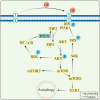Autophagy regulates apoptosis of colorectal cancer cells based on signaling pathways
- PMID: 39182013
- PMCID: PMC11344751
- DOI: 10.1007/s12672-024-01250-3
Autophagy regulates apoptosis of colorectal cancer cells based on signaling pathways
Abstract
Colorectal cancer is a common malignant tumor of the digestive system. Its morbidity and mortality rank among the highest in the world. Cancer development is associated with aberrant signaling pathways. Autophagy is a process of cell self-digestion that maintains the intracellular environment and has a bidirectional regulatory role in cancer. Apoptosis is one of the important death programs in cancer cells and is able to inhibit cancer development. Studies have shown that a variety of substances can regulate autophagy and apoptosis in colorectal cancer cells through signaling pathways, and participate in the regulation of autophagy on apoptosis. In this paper, we focus on the relevant research on autophagy in colorectal cancer cells based on the involvement of related signaling pathways in the regulation of apoptosis in order to provide new research ideas and therapeutic directions for the treatment of colorectal cancer.
Keywords: Apoptosis; Autophagy; Colorectal cancer; Signaling pathways.
© 2024. The Author(s).
Conflict of interest statement
The authors declare no competing interests.
Figures



Similar articles
-
Rational targeting of autophagy in colorectal cancer therapy: From molecular interactions to pharmacological compounds.Environ Res. 2023 Jun 15;227:115721. doi: 10.1016/j.envres.2023.115721. Epub 2023 Mar 23. Environ Res. 2023. PMID: 36965788 Review.
-
Targeting cell death signaling in colorectal cancer: current strategies and future perspectives.World J Gastroenterol. 2014 Feb 28;20(8):1923-34. doi: 10.3748/wjg.v20.i8.1923. World J Gastroenterol. 2014. PMID: 24587670 Free PMC article. Review.
-
The interaction mechanism between autophagy and apoptosis in colon cancer.Transl Oncol. 2020 Dec;13(12):100871. doi: 10.1016/j.tranon.2020.100871. Epub 2020 Sep 18. Transl Oncol. 2020. PMID: 32950931 Free PMC article. Review.
-
Palladium (II) Complex Enhances ROS-Dependent Apoptotic Effects via Autophagy Inhibition and Disruption of Multiple Signaling Pathways in Colorectal Cancer Cells.Anticancer Agents Med Chem. 2021;21(10):1284-1291. doi: 10.2174/1871520620666200929153804. Anticancer Agents Med Chem. 2021. PMID: 32990544
-
VMP1 related autophagy and apoptosis in colorectal cancer cells: VMP1 regulates cell death.Biochem Biophys Res Commun. 2014 Jan 17;443(3):1041-7. doi: 10.1016/j.bbrc.2013.12.090. Epub 2013 Dec 21. Biochem Biophys Res Commun. 2014. PMID: 24365149
Cited by
-
Prognostic Value of LC3A Protein Expression Patterns in Rectal Cancer Tumors.Cancers (Basel). 2025 May 5;17(9):1568. doi: 10.3390/cancers17091568. Cancers (Basel). 2025. PMID: 40361494 Free PMC article.
-
Lysosomes and LAMPs as Autophagy Drivers of Drug Resistance in Colorectal Cancer.Cells. 2025 Apr 11;14(8):574. doi: 10.3390/cells14080574. Cells. 2025. PMID: 40277899 Free PMC article. Review.
-
DDX3X dynamics, glioblastoma's genetic landscape, therapeutic advances, and autophagic interplay.Med Oncol. 2024 Oct 5;41(11):258. doi: 10.1007/s12032-024-02525-z. Med Oncol. 2024. PMID: 39368002 Review.
References
-
- Cancer statistics, 2024—Siegel—2024—CA: A Cancer Journal for Clinicians—Wiley Online Library, (n.d.). https://acsjournals.onlinelibrary.wiley.com/doi/10.3322/caac.21820. Accessed 31 Mar 2024. - DOI
Publication types
Grants and funding
- 82160925/National Natural Science Foundation of China
- 20224BAB206097/Jiangxi Provincial Natural Science Foundation
- CXTD22011/Jiangxi University of Chinese Medicine Science and Technology Innovation Team Development Program
- 2022-7/Young Foundation Talents in Chinese Medicine in Jiangxi Province (fourth batch)
LinkOut - more resources
Full Text Sources
